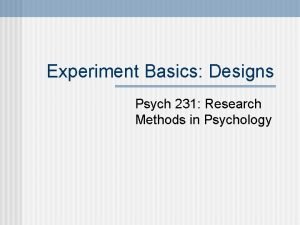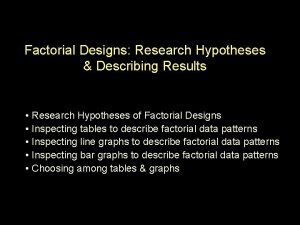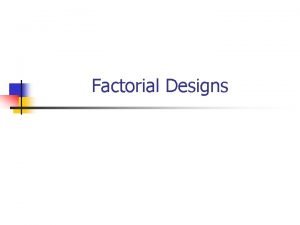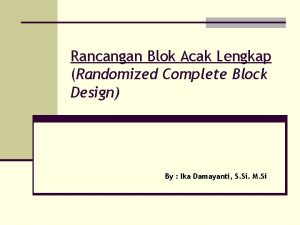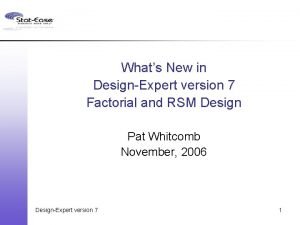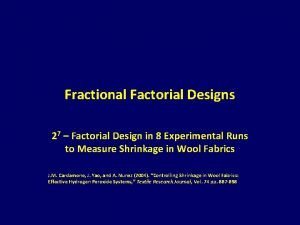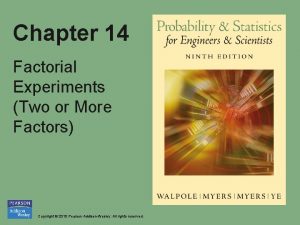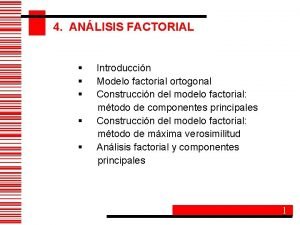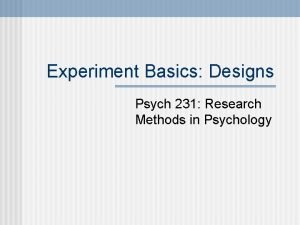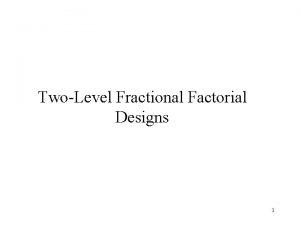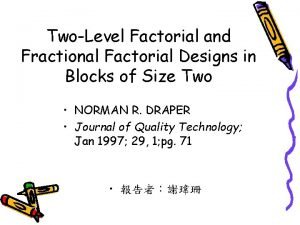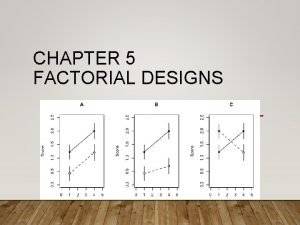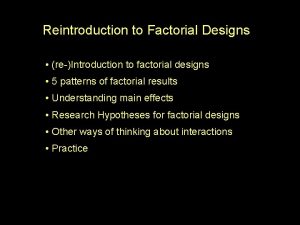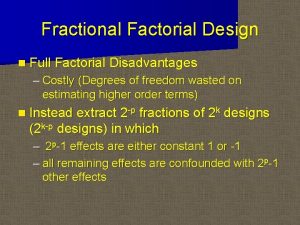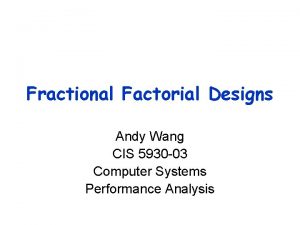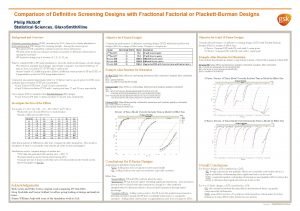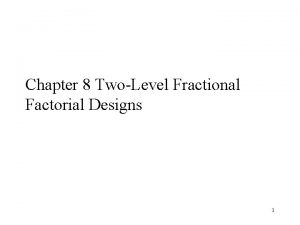Fractional Factorial Designs of Experiments P M V























- Slides: 23

Fractional Factorial Designs of Experiments P M V Subbarao Professor Mechanical Engineering Department Selection of Few Significant Parameters for Experimentation…. .

Full Factorial Design : Design Matrix

Full Factorial Design : Result Matrix

Most Significant Factor

Sample 23 Experiment 7 9 9 9 8 3 9+9+3+3 6 Main Effect of X 1 7+9+8+8 6 – 8 = -2 8

Why Fractional Factorials? Full Factorials No. of combinations For two-levels Continuous development of Knowledge is introducing more and more factors In engineering, this is the sample size -- no. of prototypes to be built.

Why so many Treatments? “There tends to be a redundancy in full factorial designs” – redundancy in terms of an excess number of interactions that can be estimated … Fractional factorial designs exploit this redundancy …” philosophy

How to select a subset of 4 runs from a 23=8 -run design? Many possible “fractional” designs

First Choice

Second Choice

Third Choice Wow! Balanced design All factors occur and low and high levels same number of times; Same for interactions Columns are orthogonal. Projections …

How to select a subset full factorial design • We note that the product of any two columns is zero. • Also the column sums are zero. • Hence three columns may be considered as vectors that form an orthogonal set. • In fact while calculating the sample variance earlier these properties were used without being spelt out.

Want to study 5 factors (1, 2, 3, 4, 5) using a 2^4 = 16 -run design i. e. , construct half-fraction of a 2^5 design = 2^{5 -1} design

DOE - Taguchi Method • Dr. Taguchi of Nippon Telephones and Telegraph Company, Japan has developed a method based on " ORTHOGONAL ARRAY " experiments. • This gives much reduced " variance " for the experiment with " optimum settings " of control parameters. • "Orthogonal Arrays" (OA) provide a set of well balanced (minimum) experiments serve as objective functions for optimization.

Taguchi Method : When to Select a ‘larger’ OA to perform “Factorial Experiments” • We always ‘think’ about ‘reducing’ the number of experiments (to minimize the ‘resources’ – equipment, materials, manpower and time) • However, doing ALL / Factorial experiments is a good idea if – Conducting experiments is ‘cheap/quick’ but measurements are ‘expensive/take too long’ – The experimental facility will NOT be available later to conduct the ‘verification’ experiment – We do NOT wish to conduct separate experiments for studying interactions between Factors

Taguchi Method Design of Experiments • The general steps involved in the Taguchi Method are as follows: • 1. Define the process objective, or more specifically, a target value for a performance measure of the process. • 2. Determine the design parameters affecting the process. • The number of levels that the parameters should be varied at must be specified. • 3. Create orthogonal arrays for the parameter design indicating the number of and conditions for each experiment. • The selection of orthogonal arrays is based on the number of parameters and the levels of variation for each parameter, and will be expounded below. • 4. Conduct the experiments indicated in the completed array to collect data on the effect on the performance measure. • 5. Complete data analysis to determine the effect of the different parameters on the performance measure.


Determining Parameter Design Orthogonal Array • The effect of many different factors on the performance characteristic in a condensed set of experiments can be examined by using the orthogonal array experimental design proposed by Taguchi. • The main factors affecting a process that can be controlled (control Factors) should be determined. • The levels at which these parameters should be varied must be determined. • Determining what levels of a variable to test requires an in-depth understanding of the process, including the minimum, maximum, and current value of the parameter. • If the difference between the minimum and maximum value of a parameter is large, the values being tested can be further apart or more values can be tested. • If the range of a parameter is small, then less values can be tested or the values tested can be closer together. • Typically, the number of levels for all parameters in the experimental design is chosen to be the same to aid in the selection of the proper orthogonal array.


Number of Levels Orthogonal Array Selector Number of Factors

Taguchi Method : How to Select a ‘larger’ OA to perform “Factorial Experiments” Control Factors Factorial and Levels Combinations Suitable OA 2 CF / 2 -levels 4 L 4 3 CF / 2 -levels 8 L 8 4 CF / 2 -levels 16 L 16 5 CF / 2 -levels 32 L 32

L 27 Array

L 50 Array
 Half fractional factorial design
Half fractional factorial design 2k factorial experiments and fractions
2k factorial experiments and fractions Within-subject design example
Within-subject design example Haskell factorial
Haskell factorial Is factorial distributive
Is factorial distributive Int factorial(int n)
Int factorial(int n) Within subjects vs between subjects
Within subjects vs between subjects Within vs between subjects
Within vs between subjects Factorial rh
Factorial rh N n factorial
N n factorial Descomposición factorial
Descomposición factorial Clojure factorial
Clojure factorial Randomized block design adalah
Randomized block design adalah Faktorial
Faktorial Spm flexible factorial
Spm flexible factorial 7 factorial
7 factorial 3 way factorial design
3 way factorial design 8 factorial
8 factorial 14factorial
14factorial Análisis factorial ejemplo
Análisis factorial ejemplo Factorial anova
Factorial anova Within participants design
Within participants design Lisp program to find factorial of a number
Lisp program to find factorial of a number Factorial example
Factorial example







